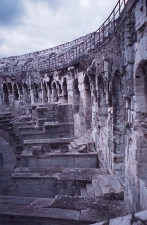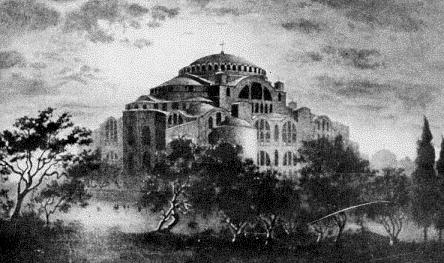Constantinople, 717 AD
 Wednesday, April 13, 2011 at 5:44AM
Wednesday, April 13, 2011 at 5:44AM One of the great challenges of writing historical fiction - particularly focusing on an era so distant from our own, in which so few original sources survive - is trying to bring a lost place and time to life, out of highly fragmentary evidence. Take, for example, the city of Constantinople, just to pick one at random. The site has been inhabited since ancient times, perhaps three millennia in total. Maybe longer. Today, there's a huge city on top of it all, a dynamic, crowded, cosmopolitan place which, much like any other modern megalopolis, has many things on its mind besides preserving one particular period of history for the archaeological convenience of people like me. I imagine a place like New York or London, but with an extra millennium or two of detritus layered underneath the modern city. And here I am, trying to pick one particular sample out of that history, no more than two or three years, and pulling that into focus, complete with buildings, streets, markets, harbors, palaces, parks, and all the rest of the things that make a city come to life. Smells. Recent controversies and urban development. Shifts in the "in places" - to eat, to live, to shop. What you would see. What you would hear. What sort of people would be on the street.Imagine, for those of you who live in a place like Athens, or Cairo, or Baltimore, a writer fifteen hundred years from now. How would they be able to figure out what the "hot" neighborhoods were? Where you ate when you were going out on the town, versus where you go when you're just picking up something for take-out. Where you buy your meat, your cheese, your bread - given that there were no super-markets at the time. It takes some real digging, more so for a culture like 8th-century Byzantium, where so few records survive.
Take, for example, the city of Constantinople, just to pick one at random. The site has been inhabited since ancient times, perhaps three millennia in total. Maybe longer. Today, there's a huge city on top of it all, a dynamic, crowded, cosmopolitan place which, much like any other modern megalopolis, has many things on its mind besides preserving one particular period of history for the archaeological convenience of people like me. I imagine a place like New York or London, but with an extra millennium or two of detritus layered underneath the modern city. And here I am, trying to pick one particular sample out of that history, no more than two or three years, and pulling that into focus, complete with buildings, streets, markets, harbors, palaces, parks, and all the rest of the things that make a city come to life. Smells. Recent controversies and urban development. Shifts in the "in places" - to eat, to live, to shop. What you would see. What you would hear. What sort of people would be on the street.Imagine, for those of you who live in a place like Athens, or Cairo, or Baltimore, a writer fifteen hundred years from now. How would they be able to figure out what the "hot" neighborhoods were? Where you ate when you were going out on the town, versus where you go when you're just picking up something for take-out. Where you buy your meat, your cheese, your bread - given that there were no super-markets at the time. It takes some real digging, more so for a culture like 8th-century Byzantium, where so few records survive. 17th century artist's rendition of the Hagia Sophia as it might have looked when it was first built.
17th century artist's rendition of the Hagia Sophia as it might have looked when it was first built.
My thanks, in this instance, to Paul Magdalino, whose "The Maritime Neighborhoods of Constantinople: Commercial and Residential Functions, Sixth to Twelfth Centuries" has been absolutely invaluable.
Reader Comments